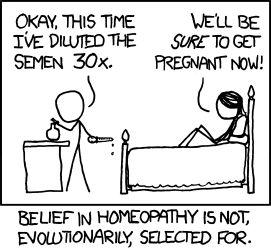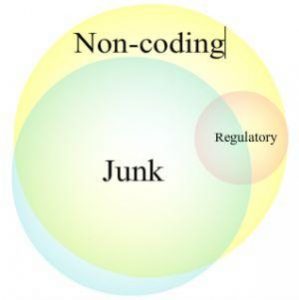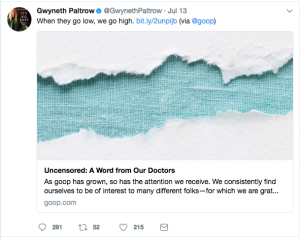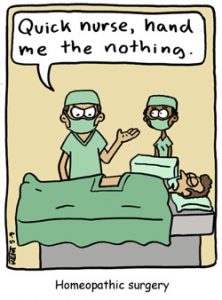Jul
31
2017
 In 1964 Fact Magazine published an article titled: “1,189 Psychiatrists say Goldwater is Psychologically Unfit to be President!” They were later sued successfully for defamation. This incident led the The Goldwater rule – Section 7 in the American Psychiatric Association’s (APA) Principles of Medical Ethics, which states it is unethical for psychiatrists to give a professional opinion about public figures they have not examined in person, and from whom they have not obtained consent to discuss their mental health in public statements.
In 1964 Fact Magazine published an article titled: “1,189 Psychiatrists say Goldwater is Psychologically Unfit to be President!” They were later sued successfully for defamation. This incident led the The Goldwater rule – Section 7 in the American Psychiatric Association’s (APA) Principles of Medical Ethics, which states it is unethical for psychiatrists to give a professional opinion about public figures they have not examined in person, and from whom they have not obtained consent to discuss their mental health in public statements.
This rule has held sway for the last 50 years. However, recently the American Psychoanalytic Association (APsaA) e-mailed its members to inform them that they are not constrained by the Goldwater rule. So which stance is correct?
There are two competing ethical principles at stake. The first is the ethical responsibility of professionals not to cause harm to someone else by making public statements they have no business making. This is especially true when it comes to psychiatric diagnoses, because they carry a heavy and (in my opinion) unjustified stigma. The mere fact of being a public figure does not mean that medical professionals are free to bypass confidentiality and consent to make public speculations about your mental health.
Further, psychiatric diagnoses are especially complex and subjective. In order to make a accurate diagnosis you need a lot of background information about a person, and you need some professional interaction. This should ideally be a personal examination, however watching a video of another professional conducting an examination could suffice. But even then, the purpose of psychiatric diagnoses is to guide therapy. They are still fuzzy and subjective entities. It seems profoundly unethical to turn them against an individual, and use a formal diagnosis to medicalize their personality and behavior for non-therapeutic purposes.
When dealing with politicians, it is further very difficult for professionals to filter out their own ideology or personal feelings. It becomes too easy to use the tools of medicine for political fighting.
Continue Reading »
Jul
28
2017
 As with most things, the answer is more complicated than it may at first seem.
As with most things, the answer is more complicated than it may at first seem.
Up to now the official answer was simple – always finish prescribed courses of antibiotics. Stopping early, it was argued, could increase the risk of antibiotic resistance. The idea is that bacteria which are a little resistant to the antibiotic will survive longer, and if they are not wiped out by completing the course, the partially resistant bugs will then reproduce, with random mutations leading to greater resistance. The antibiotics are essentially a selective pressure leading to resistance.
This makes sense, and is almost certainly true with certain chronic infections, such as tuberculosis.
A new review, however, suggests that we cannot apply this rule simplistically to all infections. It depends on the type of bacteria involved.
Continue Reading »
Jul
27
2017
It is very disheartening for me to listen to the political discussions surrounding health care. I can’t help thinking that the proposed changes amount to rearranging the furniture on the deck of the Titanic.
This is not to say that there aren’t important policy decisions at stake. It is important that everyone has health coverage, as a matter of efficiency and just compassion. However, the health care debate is often framed as an attempt to reduce health care costs. This is where the rearranging the deck furniture metaphor is apt.
There are some minor efficiencies to be gained in how we pay for health care, but that is not going to touch the real driver of rising health care costs – technology. Of course there are multiple factors, but the main one is the fact that we have the technology to deliver more care and more expensive care, and to keep people alive longer. This is combined with a culture that demands expensive care. We want MRI scans for every ailment, and the most aggressive procedures to keep our loved ones going for as long as possible.
More care and higher tech care costs more money.
Continue Reading »
Jul
25
2017
 When I was about 10 my family flew to California to visit my uncle. The flight from New York to LA took about 6 hours. Forty years later a flight from New York to LA still takes about 6 hours (exact flight times vary by airline, but 6 hours is typical).
When I was about 10 my family flew to California to visit my uncle. The flight from New York to LA took about 6 hours. Forty years later a flight from New York to LA still takes about 6 hours (exact flight times vary by airline, but 6 hours is typical).
The pace of technological advance in the last century has been so fast that we generally expect everything to get faster, better, cheaper as a matter of course. So the flat commercial travel times seems to be a weird exception.
Airline travel has improved over this time. Jets have become safer and more fuel efficient. Average costs of flights have decreased by about 50%, although apparently this had more to do with deregulation than technology. It may also have something to do with the shrinking legroom in economy class. But still, why does it take me 6 hours to fly across the country?
There are a number of reasons for the flat commercial flight speeds, which make it seem that there is unlikely to be a change anytime soon.
Supersonic Flight
The first factor that most people likely consider is that we are pushing up against the sound barrier. This is partly true, but not the whole story. The Concorde, which was the only commercial supersonic jet, was retired in 2003. This was mainly because flights were too expensive and it wasn’t commercially viable. There have been no plans to bring it back or replace it.
Continue Reading »
Jul
21
2017
 I have long considered homeopathy to be the softest of targets for skeptics, especially in the area of alternative medicine. Homeopathy is 100% pure nonsense. It is a pre-scientific magical form of medicine that has no legitimate place in the modern world.
I have long considered homeopathy to be the softest of targets for skeptics, especially in the area of alternative medicine. Homeopathy is 100% pure nonsense. It is a pre-scientific magical form of medicine that has no legitimate place in the modern world.
Further, homeopathy is particularly vulnerable because most people do not know how silly it is. They think it is natural or herbal medicine, but it’s not. Homeopathy involves taking fanciful treatments and then diluting them out of existence, based on the notion that the essence of the substance will be left behind and magically cure whatever ails you.
This means that simply educating the public about what homeopathy actually is can be an effective way to reduce its popularity. Knowledge is not sufficient, however, because there is no limit to what people are capable of believing. Nonsense is rarely eradicated entirely, but we can certainly restrict it to the fringe where it belongs.
Homeopathy in Australia
In 2015 the Australian National Health and Medical Research Council (NHMRC) concluding that homeopathic treatments were worthless, and that the scientific evidence has not shown that they work for any single indication.
Continue Reading »
Jul
20
2017
 There is something appealing about the fact that while there was so much controversy and public debate about global warming and energy production, solar cell technology incrementally improved in the background, largely unnoticed, until it became an actual cost-effective option for energy production. There were no breakthroughs or big announcements, just a slow increase in efficiency and decrease in cost.
There is something appealing about the fact that while there was so much controversy and public debate about global warming and energy production, solar cell technology incrementally improved in the background, largely unnoticed, until it became an actual cost-effective option for energy production. There were no breakthroughs or big announcements, just a slow increase in efficiency and decrease in cost.
Slow incremental changes add up, like a conservative but reliable investment. In 1941 the first silicon-based solar cells were developed with <1% energy conversion efficiency. In 2009 we broke 25% efficiency. The current record efficiency for mass-produced solar cells is 26.6%.
While more efficiency is always welcome, this is now more than enough for most practical uses of solar cells. The solar panels on the roof of my house (which doesn’t even cover my entire available roof space) produces 100% of the energy (averaged over the year) that my house consumes. Obviously, your mileage may vary, depending on roof orientation, shading, and geographic location. I live in CT, which is hardly a sunny state, so anywhere in the US should be viable for solar energy. If you life somewhere like Arizona, it’s a no-brainer.
With many technologies there is one feature that is considered a limiting factor, or at least the most important factor, at least by the public, and tends to dominate discussion. For computers it used to be processor speed, for cameras it was megapixels. Once, however, we get to the point where these parameters are generous enough to no longer be the dominant limiting factor, we start to pay attention to other factors. Make no mistake, these other factors were important all along, they were just often neglected by the public who focused on one number.
Continue Reading »
Jul
18
2017
 Junk DNA, put simply, is those parts of the genome (human or otherwise) that have no known function. The human genome has about 19,000 genes. A gene is essentially a sequence of base pairs that code for a protein – there are four difference bases with each triplet being a “word” that either codes for an amino acid or tells the process of transcribing the protein to stop.
Junk DNA, put simply, is those parts of the genome (human or otherwise) that have no known function. The human genome has about 19,000 genes. A gene is essentially a sequence of base pairs that code for a protein – there are four difference bases with each triplet being a “word” that either codes for an amino acid or tells the process of transcribing the protein to stop.
Even within genes there are noncoding regions, called introns, which have to be removed from the RNA so that the coding regions can be joined together. Between the genes there are also vast non-coding regions. Some of this non-coding DNA is regulatory and structural – it helps regulate when and how much specific genes are transcribed into proteins.
The burning question is, how much of the non-coding regions between the genes serves any function and how much is completely unnecessary, or “junk”? This is an important question for understanding genetics, but also has implication for creationists. Creationists don’t like the concept of junk DNA because it strongly implies an evolutionary history. Why would a designer sloppily insert so much unneeded junk into our pristine genome? Why are genes clogged with non-coding regions that need to be removed? So they claim that all DNA has function, we just don’t know what it is.
ID proponent Stephen Meyer, for example, said:
“For example, we predicted very early on that the junk DNA was not junk. We did that on the basis of an ID perspective. “
Continue Reading »
Jul
17
2017
 In my last post I discussed how Paltrow and her people over at goop launched a personal attack against Dr. Jen Gunter, an OB/GYN blogger who has taken the time to point out a lot of the nonsense that goop sells. Goop has been criticized by many science bloggers and mainstream outlets for fearmongering to women in order to sell dubious products.
In my last post I discussed how Paltrow and her people over at goop launched a personal attack against Dr. Jen Gunter, an OB/GYN blogger who has taken the time to point out a lot of the nonsense that goop sells. Goop has been criticized by many science bloggers and mainstream outlets for fearmongering to women in order to sell dubious products.
For some reason “team goop” did not go after Science-Based Medicine, or Tim Caulfield, or Steven Colbert – they went after one humble medical science blogger. This is particularly ironic because Gunter’s blogging career is all about empowering women with science-based information, about advocating for women’s health and autonomy. I can only suppose that goop went after her because they felt particularly stung by her on-target criticism, or perhaps they thought she was an easy target for bullying.
The irony is thickened by including a response from Dr. Steven Gundry, who takes a particularly condescending tone and actually earns the often overused description of “mansplaining.”
The result was the typical litany of alternative medicine tropes, bad logic, and bad science, wrapped in a personal attack against Gunter. But they did leave themselves wide open for poking some additional fun at them, in order to point out how intellectually vacuous and dishonest they are. Dr. Gunter just drove a Mack truck through that opening.
Continue Reading »
Jul
14
2017
 Gwyneth Paltrow has been using her celebrity to promote a “lifestyle brand” she calls “Goop.” The site recommends all sorts of medical nonsense, like detox, earthing, putting stuff up your vagina, and the usual scaremongering about “toxins” or whatever. Recently I wrote about Goop’s promotion of magical stickers that are alleged to align and balance your vibrations.
Gwyneth Paltrow has been using her celebrity to promote a “lifestyle brand” she calls “Goop.” The site recommends all sorts of medical nonsense, like detox, earthing, putting stuff up your vagina, and the usual scaremongering about “toxins” or whatever. Recently I wrote about Goop’s promotion of magical stickers that are alleged to align and balance your vibrations.
Deservedly she has received push back from science communicators who are trying to raise the level of scientific literacy and critical thinking in the world. The concern is that she is spreading misinformation and pseudoscience, which is increasingly harmful in our modern technological world.
One highly vocal critic has been Dr. Jen Gunter, an OB who is particularly offended by the fact that Paltrow wraps her pseudoscientific misinformation in “female empowerment.” I’m sorry, but taking advantage of women by scaring them and selling them nonsense is not empowering – it’s exploitation. Apparently Goop has been stung by this criticism, and decided to hit back. The results are predictably awful, but do provide an opportunity to deconstruct some popular anti-intellectual nonsense.
“Team goop” begins:
As goop has grown, so has the attention we receive. We consistently find ourselves to be of interest to many—and for that, we are grateful—but we also find that there are third parties who critique goop to leverage that interest and bring attention to themselves.
Continue Reading »
Jul
13
2017
 There is a lot to be horrified about regarding the alternative medicine (CAM) industry. The industry largely trades in fraud and misinformation at the expense of the public’s health. But I often find myself most dismayed by what the industry says about the relationship between humans and reality.
There is a lot to be horrified about regarding the alternative medicine (CAM) industry. The industry largely trades in fraud and misinformation at the expense of the public’s health. But I often find myself most dismayed by what the industry says about the relationship between humans and reality.
I have discussed over the years the many ways, mostly revealed through psychological research, but also with many specific examples, in which people build their narratives about the world and how these narratives trump reality and often even basic logic. If you ever doubt the ability of people to erect a false narrative and worship it as truth, remember that there are people who believe, in the 21st century, that the Earth is flat.
Humans, however, also have science, philosophy, logic, and reason. We have managed, especially in the last few centuries, to collectively crawl out of a deep pit of self-deception and slowly accumulate real knowledge about the universe and how it works. As a species we have this weird dual nature, at times rigorously rational, and at others hopelessly gullible and ideological.
What is perhaps most concerning about the CAM phenomenon is what it tells us about the balance between reason and deception. Sitting on top of the last few centuries of scientific progress, it certainly seems like science and reason are winning. But perhaps this vantage point gives us a biased perspective. Over this period we have largely shifted from a pre-scientific view of the world to a scientific one. Science then showcased its power by picking a lot of the low-hanging fruit – answering the easiest questions to answer.
Continue Reading »
 In 1964 Fact Magazine published an article titled: “1,189 Psychiatrists say Goldwater is Psychologically Unfit to be President!” They were later sued successfully for defamation. This incident led the The Goldwater rule – Section 7 in the American Psychiatric Association’s (APA) Principles of Medical Ethics, which states it is unethical for psychiatrists to give a professional opinion about public figures they have not examined in person, and from whom they have not obtained consent to discuss their mental health in public statements.
In 1964 Fact Magazine published an article titled: “1,189 Psychiatrists say Goldwater is Psychologically Unfit to be President!” They were later sued successfully for defamation. This incident led the The Goldwater rule – Section 7 in the American Psychiatric Association’s (APA) Principles of Medical Ethics, which states it is unethical for psychiatrists to give a professional opinion about public figures they have not examined in person, and from whom they have not obtained consent to discuss their mental health in public statements.
 As with most things, the answer is more complicated than it may at first seem.
As with most things, the answer is more complicated than it may at first seem. When I was about 10 my family flew to California to visit my uncle. The flight from New York to LA took about 6 hours. Forty years later a flight from New York to LA still takes about 6 hours (exact flight times vary by airline, but 6 hours is typical).
When I was about 10 my family flew to California to visit my uncle. The flight from New York to LA took about 6 hours. Forty years later a flight from New York to LA still takes about 6 hours (exact flight times vary by airline, but 6 hours is typical). I have long considered homeopathy to be the softest of targets for skeptics, especially in the area of alternative medicine.
I have long considered homeopathy to be the softest of targets for skeptics, especially in the area of alternative medicine.  There is something appealing about the fact that while there was so much controversy and public debate about global warming and energy production, solar cell technology incrementally improved in the background, largely unnoticed, until it became an actual cost-effective option for energy production. There were no breakthroughs or big announcements, just a slow increase in efficiency and decrease in cost.
There is something appealing about the fact that while there was so much controversy and public debate about global warming and energy production, solar cell technology incrementally improved in the background, largely unnoticed, until it became an actual cost-effective option for energy production. There were no breakthroughs or big announcements, just a slow increase in efficiency and decrease in cost. Junk DNA, put simply, is those parts of the genome (human or otherwise) that have no known function. The human genome has about
Junk DNA, put simply, is those parts of the genome (human or otherwise) that have no known function. The human genome has about  In my last post
In my last post Gwyneth Paltrow has been using her celebrity to promote a “lifestyle brand” she calls “Goop.” The site recommends all sorts of medical nonsense, like detox, earthing, putting stuff up your vagina, and the usual scaremongering about “toxins” or whatever.
Gwyneth Paltrow has been using her celebrity to promote a “lifestyle brand” she calls “Goop.” The site recommends all sorts of medical nonsense, like detox, earthing, putting stuff up your vagina, and the usual scaremongering about “toxins” or whatever.  There is a lot to be horrified about regarding the alternative medicine (CAM) industry. The industry largely trades in fraud and misinformation at the expense of the public’s health. But I often find myself most dismayed by what the industry says about the relationship between humans and reality.
There is a lot to be horrified about regarding the alternative medicine (CAM) industry. The industry largely trades in fraud and misinformation at the expense of the public’s health. But I often find myself most dismayed by what the industry says about the relationship between humans and reality.




